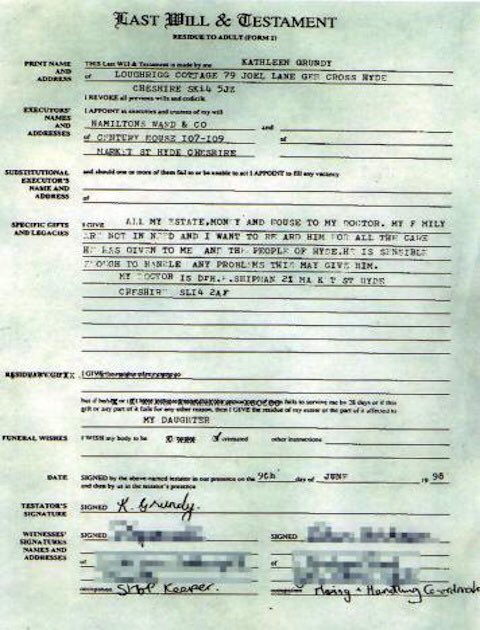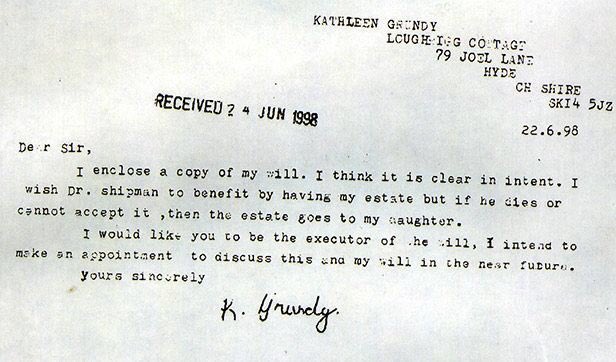Shipman trial - the ‘will’.
On day 6 the two witnesses to the will testified. I cannot work out from their evidence what Shipman was playing at. Maybe you can.
Paul Spencer remembered attending the surgery on 9th Jun (the date of the will) & together with another ..
On day 6 the two witnesses to the will testified. I cannot work out from their evidence what Shipman was playing at. Maybe you can.
Paul Spencer remembered attending the surgery on 9th Jun (the date of the will) & together with another ..
.. patient, Claire Hutchinson, being asked by Shipman to witness ‘something’. They followed him to his office. There was an elderly lady sitting at a table. Spencer sat beside her & signed at the bottom of a sheet of paper which had been folded over so that he could only ..
.. see the bottom. He recalled seeing the signature ‘K Grundy’ to the extreme right & he signed on the left, adding his address & occupation. Note that the Grundy signature is not on the right of the ‘will’. He left the room as Hutchinson was signing.
He was shown the ..
He was shown the ..
.. purported will in court & firmly denied the signature was his. In cross examination he reluctantly admitted he had been paid a total of £300 for two newspaper interviews.
Hutchinson testified to the same event but with two important differences. First, what she signed was ..
Hutchinson testified to the same event but with two important differences. First, what she signed was ..
.. overlain with a sheet of paper, not folded over, but not so as to prevent her seeing the words ‘last will and testament’. Second, she positively identified Mrs Grundy as the elderly lady present, accurately estimating her age as ‘late 70s’ & describing her as sprightly. ..
.. Her identification evidence was based on photographs she saw when the case made the news.
She firmly repudiated the address written on the will which she said was not hers (something not developed by either counsel) and with less certainty denied the signature was hers.
..
She firmly repudiated the address written on the will which she said was not hers (something not developed by either counsel) and with less certainty denied the signature was hers.
..
.. For completeness, a fingerprint expert testified to finding a print belonging to Shipman on the will & a handwriting expert, whose evidence was not challenged by the defence, testified the signatures on the will & on the 22 Jun letter were forgeries.
Now, I just can’t ..
Now, I just can’t ..
.. figure out what’s going on here. I know Shipman had to contrive a signing event so the two witnesses, if questioned later, would be able to recall it, hopefully being hazy about the details. But what, given her daughter’s very firm & credible evidence that her ..
.. mother would never have made a will in this manner, was Mrs Grundy doing there? The daughter was herself a solicitor & had made her mother’s will in 1986 (tiny bit odd that, as solicitors aren’t supposed to be directly involved in making wills from which they benefit, but ..
.. it’s irrelevant here) so she was the obvious person to turn to to make a new will.
On the other hand, the new will entirely cut her daughter out of the inheritance & Mrs Grundy may not have felt comfortable telling her.
In his police interview Shipman denied knowledge ..
On the other hand, the new will entirely cut her daughter out of the inheritance & Mrs Grundy may not have felt comfortable telling her.
In his police interview Shipman denied knowledge ..
.. of the will but admitted that something was signed & witnessed in his surgery on 9th Jun. Hutchinson had already told the police about seeing the words ‘last will and testament’ so it’s not something she embellished later under the influence of press reports. ..
.. In the course of typing this thread I have had a eureka moment. Suppose Mrs Grundy had told Shipman she wanted to leave a part of her estate, perhaps a small legacy, to him or to the practise & he had offered to knock up the will on pre-printed stationery to avoid the ..
.. usual fuss & bother.
He then drew .. the will on his typewriter (the forgery was certainly typed out on his Brother typewriter) giving a small sum to the surgery & the residue to the daughter. Mrs Grundy made no mention of it to her daughter from embarrassment or guilt at ..
He then drew .. the will on his typewriter (the forgery was certainly typed out on his Brother typewriter) giving a small sum to the surgery & the residue to the daughter. Mrs Grundy made no mention of it to her daughter from embarrassment or guilt at ..
.. not asking her to do it. He arranged execution in the manner described by the witnesses & then used another identical stationery form to make the forgery.
This theory fails to explain why Claire Hutchinson’s address was wrong which makes it more frustrating that counsel ..
This theory fails to explain why Claire Hutchinson’s address was wrong which makes it more frustrating that counsel ..
.. did not delve into the anomaly at trial. Still, it’s the best I can manage.
It makes the Grundy case anomalous in two ways. The idea for most of the murders seems to have been hatched no more than a day or two before they were carried out but here there is a suggestion of ..
It makes the Grundy case anomalous in two ways. The idea for most of the murders seems to have been hatched no more than a day or two before they were carried out but here there is a suggestion of ..
.. premeditation going back a couple of weeks. And the second, of course, was that the forged will, with its dramatic effect, would cast suspicion on him.
While I’m typing, another thought occurs to me concerning the 28 Jun letter from the mysterious J or S Smith. ..
While I’m typing, another thought occurs to me concerning the 28 Jun letter from the mysterious J or S Smith. ..
.. I will attach it to the thread when I find it. The letter told the solicitors Mrs Grundy was dead & claimed authorship of the will, giving no sender’s address. It was thus obviously suspicious. Why did Shipman send it?
My bet is he was anxious that the body should be ..
My bet is he was anxious that the body should be ..
.. cremated, as the forgery directed. Mrs Grundy’s daughter, knowing nothing of the forgery of course & never having discussed her mother’s preferences, had decided to have her buried, a fact she may have mentioned to Shipman on one of the several occasions they conversed.
It was part if Shipman’s modus, not always successful, to ensure his victims were cremated in order to destroy the evidence of morphine. In this case, he may have realised cremation was more than usually important &, in his anxiety, he sent the Smith letter to get the ..
.. solicitors involved as executors in the funeral arrangements.
That’s it for the moment. Now I must go and find that letter.
That’s it for the moment. Now I must go and find that letter.

 Read on Twitter
Read on Twitter



